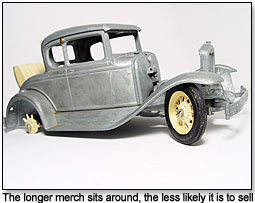
December 13, 2025

March 2012 | Vol. XI - No. 3
3 Tips for Dealing With Merchandise That Won't Sell
 When I was just out of college I lived with a couple of roommates. We took turns buying the groceries, depending on what we needed.
When I was just out of college I lived with a couple of roommates. We took turns buying the groceries, depending on what we needed.
One day I poured a glass of fermented milk with clots and mold into a glass. My roommate’s excuse? “I couldn’t see it!”
Think of your inventory like you would fresh milk. Unless you look at it, you end up with spoiled, stained and unsellable merch.
Selling your inventory is the only way you make money.
Yet, for many, inventory management and rotation is misunderstood. Your merch has to come and go on a regular basis, or it will rot. Would you want to buy ten gallons of milk, but end up with most of it spoiled? No! You decide how much milk to buy depending on how much you go through. The same must be true of your merchandise.
If you buy too much inventory, it will go bad.
When you are buying merchandise, you’re certainly hopeful that it will sell; but your orders have to be based on more than a hunch if you want to grow your business. The proper way to do this is with an Open-to-Buy system. Your stock levels must correspond with your most recent sales trends. For example, you can order 10% more merchandise if sales grew 10% in the previous two months.
In 2008, retail giant Nordstrom decided to shrink its year-end inventory per square foot by 12 % from the previous year, reducing their supplies in line with shrinking demand. That poised them for future growth with new merch, rather than leaving them with stockpiles of unsold goods like Macy’s — a store that was practically giving stuff away with 70 and 80% off.
 Don’t hold on to past failures.
Don’t hold on to past failures.
If it didn’t sell when it was new, don’t think it suddenly will six months later when your employees are cold to it. It’s best to identify as quickly as possible what is not performing, move it out, and bring in fresh merchandise. That allows you to get more of the right merch so you can grow profits.
While that sounds simple, you’ve likely had the experience of telling your manager, “We are going to get rid of product X because it’s not selling,” and had your manager reply, “We can’t get rid of it, we sell tons of it!” Then you went to your POS reports, and found you only sold a handful. That’s because most employees remember their last sale most vividly, or the last thing a customer requested that you didn’t have.
To get the big picture you need to use a category sales report from your POS system to determine correct inventory levels. Otherwise, you might think an item being gone is reason enough to reorder.
However, missing stock could be due to a number of things other than demand, such as theft: customers taking it when no one is looking, or employees lifting it as they take out the trash. You’ll never know unless you look carefully at your category reports.
All of your categories should be able to be profitable. Again, shopworn merch is like sour milk; people avoid it.
Take aggressive markdowns during the busiest times of year when people are coming into the store, rather than waiting for slow periods when you’ll be left with merch that is impossible to move.
Copyright © 2025 TDmonthly®, a division of TOYDIRECTORY.com®,
Inc.



 When I was just out of college I lived with a couple of roommates. We took turns buying the groceries, depending on what we needed.
When I was just out of college I lived with a couple of roommates. We took turns buying the groceries, depending on what we needed. Don’t hold on to past failures.
Don’t hold on to past failures.